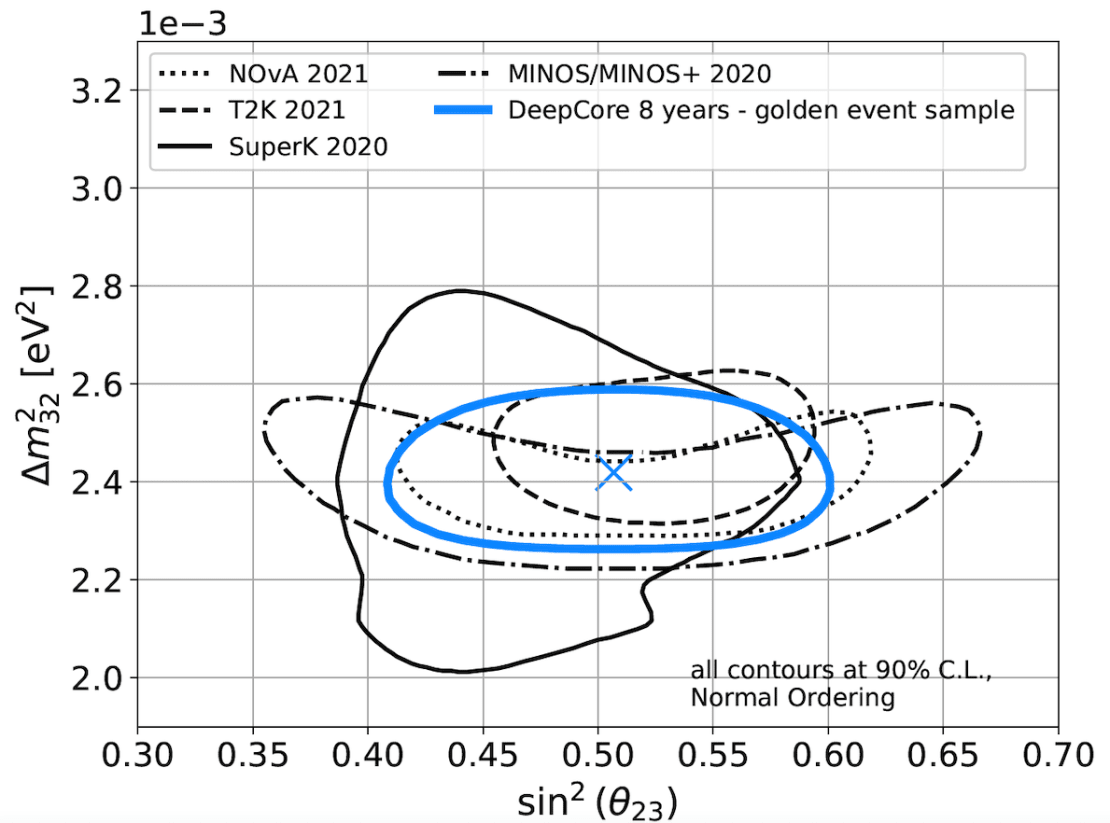When cosmic rays strike Earth’s atmosphere, they produce air showers containing atmospheric muons and neutrinos—tiny, nearly massless particles—that rain down on Earth. The atmospheric neutrinos are then detected by the IceCube Neutrino Observatory at the South Pole.
These atmospheric neutrinos come in three different flavors—electron, muon, and tau–and can become a different flavor or “oscillate” as they propagate. One of the goals of IceCube is to better understand atmospheric “mixing” parameters and improve detection of atmospheric neutrino oscillations.
In a paper recently submitted to Physical Review D, the IceCube Collaboration describes a new data sample for which they report on the latest measurement of atmospheric neutrino oscillations. The collaborators used DeepCore, a subdetector of IceCube sensitive to neutrinos above approximately 10 GeV, or about 100 times lower in energy than the main IceCube detector. The sample used includes significant improvements in data calibration, detector simulation, and data processing, resulting in the most precise measurement to date of oscillation parameters using atmospheric neutrinos.

“We had done studies of this type before, but now we wanted to truly harness the full power of DeepCore data by making a new data sample that incorporates all the lessons learned from our own previous analyses as well as improvements in our understanding of the detector and Antarctic ice,” says Juan Pablo Yañez, assistant professor at the University of Alberta, who coordinated the initial steps of the study. “This was an enormous collaborative effort, and now we have the first results from it.”
The new data sample taken from DeepCore contained data recorded between 2011–2019. For the study, collaborators simulated IceCube neutrino events that precisely matched the behavior of real neutrino events.
“To measure neutrino oscillation parameters, we weighted every simulated event by its survival probability according to its energy, flavor, and the distance it traveled through the Earth,” says Alex Trettin, a PhD student at Deutsches Elektronen-Synchrotron (DESY) and one of the key contributors to the analysis. “We then adjusted the parameters until the weighted distribution of simulated events matched that of the observed events in our dataset as closely as possible.”
The collaborators saw a significant reduction in the number of atmospheric muon neutrinos that crossed Earth due to these neutrino oscillations.
“With this clear observation of muon neutrino disappearance, we were able to constrain the atmospheric mixing parameters to the highest precision ever achieved using atmospheric neutrinos, using less than 10% of our available data,” says Summer Blot, a staff scientist at DESY and co-convenor of the oscillations working group, who supervised much of the work to obtain the first result from the new data sample. “Our results are consistent and complementary with other long-baseline experiments, since we use significantly higher energy neutrinos that are subject to different kinds of uncertainties.”
The study demonstrated the IceCube detector’s capabilities in performing precision neutrino oscillation measurements. More measurements are on the way with a much larger dataset, and with the deployment of the IceCube Upgrade—which will add seven new strings of optical modules in the center of the existing detector array in 2025–2026—IceCube is set to make even more precise measurements over the next decade and beyond.
“We are now building from this successful foundation to perform new, even more precise oscillation measurements that leverage the full statistical power afforded by IceCube’s colossal size,” says Tom Stuttard, assistant professor at the Niels Bohr Institute and colead on the analysis. “The number of neutrinos used will be increased by nearly a factor of ten, and we will be able to test more exotic theories that could modify the observed oscillations.”
+ info “Measurement of Atmospheric Neutrino Mixing with Improved IceCube DeepCore Calibration and Data Processing,” IceCube Collaboration: R. Abbasi et al., Physical Review D 108 (2023) 1, 012014, journals.aps.org, arXiv